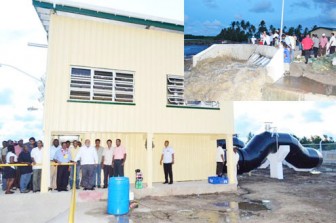The $200 million Greenfield drainage pump station, designed to drain approximately 3,000 acres of residential and farm lands on the East Coast of Demerara, was commissioned on Thursday.
The pump station will be operated at a combined discharge capacity of 300-cubic feet per second and will be managed by the National Drainage and Irrigation Authority (NDIA) to serve the areas extending from Unity and Hope Estate in the east, and Crown Dam in the south, the Government Information Agency (GINA) reported.

In explaining the genesis of the project, NDIA Chief Executive Officer (CEO) Lionel Wordsworth was quoted as saying that between 2005 and 2006, it was discovered that the existing sluice was showing signs of deterioration in the form of its discharging capacity. The project was not conceptualised, however, until 2009, subsequent to a visit to the areas by then President Bharrat Jagdeo. The contract which was signed in September 2009 was awarded to Harrychand Tulsi.
The project forms part of the NDIA’s 2012 programme as well as the agency’s wider master plan, GINA said.
Speaking during the commissioning, President Ramotar said that drainage pump stations are essential in ensuring the nation’s food security. And in light of the significant growth in world population to seven billion, he added that many developed countries have been moving into third world countries to acquire large tracts of land, “fundamentally to secure their own food supply.”
“Guyana on the other hand, has an ideal opportunity to develop its agriculture base and ensuring its own food security, as well as that of the region,” he said.
Ramotar, however, noted that the country still imports about US$3 billion to US$4 billion worth of food every year, “which can be reduced given the fact that it has the capacity to produce enough food.” Some of the some of the main factors in achieving this objective, he added, includes arable land and fresh water, and effective drainage and irrigation (D&I) systems, especially in communities that depend heavily on farming.
According to GINA, pump stations have been rehabilitated in Stanleytown, in Region Three, and Liliendaal and Kitty, in Region Four. “Additionally, under the Agriculture Support Services Programme, pumps stations have been rehabilitated at Victoria and Cane Grove and new pumps were installed at Lusignan, Region Four and at Number 19 and 42 Villages in Region Six. Meanwhile, pumps were rehabilitated at Trafalgar, Region Five, and Anna Regina and Cozier in Region Two,” it added.
GINA also said that other pump stations and sluices will soon be built at Canals Polder, in Region Three and Black Bush Polder, in Region Six. “In another year’s time, we will probably have an additional 14 sluices and pumps installed on the coastland as we try have the right conditions for the development of our agriculture,” President Ramotar said. He also called on citizens to take a personal interest in ensuring that the structures function effectively, so that as the primary beneficiaries can derive optimum benefits. The President also lamented the irresponsible dumping of garbage in drains and other waterways; which, in effect, contributes to flooding.
Minister of Agriculture Dr. Leslie Ramsammy was quoted as saying that given the inevitability of climate change, systems have to be put in place to mitigate the devastating effects of flood and drought.
Dr. Ramsammy reiterated government’s commitment to proceed with the reconstruction of the Cunha Canal, with funds from the Guyana-Norway forest agreement. He said this project would help to keep the East Demerara Water Conservancy (EDWC) safe, while bringing much needed relief to residents at Mahaica, Mahaicony and Abary. The Minister added that World Bank officials are in Guyana and are consulting with officials from the NDIA to finalise the design and other aspects of the project.





